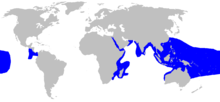Whitetip reef shark
| Whitetip Reef Shark | |
|---|---|
 |
|
| Scientific classification | |
| Kingdom: | Animalia |
| Phylum: | Chordata |
| Class: | Chondrichthyes |
| Subclass: | Elasmobranchii |
| Superorder: | Selachimorpha |
| Order: | Carcharhiniformes |
| Family: | Carcharhinidae |
| Genus: |
Triaenodon J. P. Müller & Henle, 1837 |
| Species: | T. obesus |
| Binomial name | |
|
Triaenodon obesus (Rüppell, 1837) |
|
 |
|
| Range of the whitetip reef shark | |
| Synonyms | |
|
Carcharias obesus Rüppell, 1837 |
|
Carcharias obesus Rüppell, 1837
Triaenodon apicalis Whitley, 1939
The whitetip reef shark (Triaenodon obesus) is a species of requiem shark, in the family Carcharhinidae, and the only member of its genus. A small shark usually not exceeding 1.6 m (5.2 ft) in length, this species is easily recognizable by its slender body and short but broad head, as well as tubular skin flaps beside the nostrils, oval eyes with vertical pupils, and white-tipped dorsal and caudal fins. One of the most common sharks found on Indo-Pacific coral reefs, the whitetip reef shark occurs as far east as South Africa and as far west as Central America. It is typically found on or near the bottom in clear water, at a depth of 8–40 m (26–131 ft).
During the day, whitetip reef sharks spend much of their time resting inside caves. Unlike other requiem sharks, which rely on ram ventilation and must constantly swim to breathe, this shark can pump water over its gills and lie still on the bottom. At night, whitetip reef sharks emerge to hunt bony fishes, crustaceans, and octopus in groups, their elongate bodies allowing them to force their way into crevices and holes to extract hidden prey. Individuals may stay within a particular area of the reef for months to years, time and time again returning to the same shelter. This species is viviparous, in which the developing embryos are sustained by a placental connection to their mother. One of the few sharks in which mating has been observed in the wild, receptive female whitetip reef sharks are followed by prospective males, which attempt to grasp her pectoral fin and maneuver the two of them into positions suitable for copulation. Females give birth to one to six pups every other year, after a gestation period of 10–13 months.
...
Wikipedia

